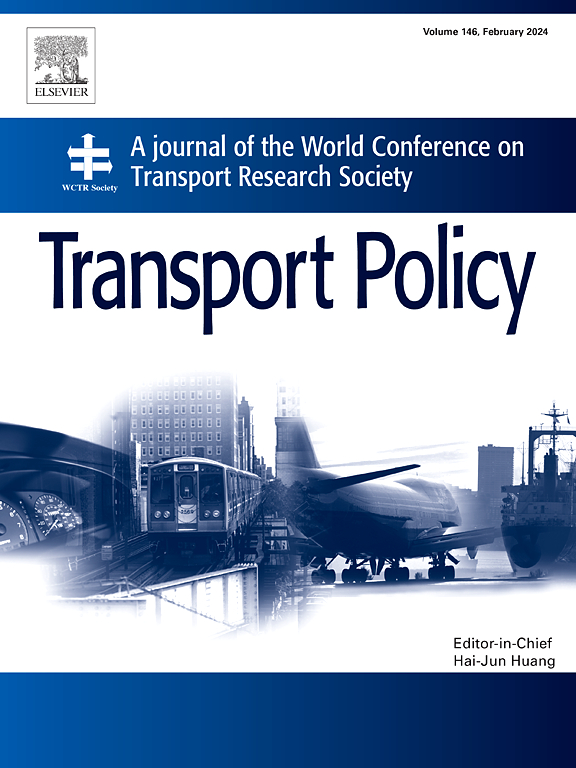通过工业搬迁优化多周期货运网络:土地使用与运输互动建模方法
IF 6.3
2区 工程技术
Q1 ECONOMICS
引用次数: 0
摘要
本研究提出了一种带工业搬迁的多期货运网络设计问题(MPNDP-IR)的优化方法。首先,建立了一个土地利用运输相互作用(LUTI)模型,以定量描述工业搬迁行为与货运网络升级之间错综复杂的相互作用。然后,将所提出的 LUTI 模型整合到双层规划框架中,以有效优化多期网络投资策略,实现产业转移和货运中转效益的最大化。最后,以长江经济带为例,研究结果表明,区位效用的敏感性会显著影响货运网络投资政策的效益影响范围,从而影响产业转移模式。在制造业活动中,原材料和化工行业对重要铁路走廊沿线的网络投资政策反应最为敏感。在低敏感度情景下,此类产业的搬迁模式与梯度搬迁模式一致;而在高敏感度情景下,则倾向于选择 "飞入 "模式。本研究提供了一种针对 MPNDP-IR 的决策支持方法。它不仅模拟了不同产业活动与货运网络升级的共同演化,还评估了产业转移背景下多周期网络投资政策的时空影响。本文章由计算机程序翻译,如有差异,请以英文原文为准。
Optimizing multi-period freight networks through industrial relocation: A land-use transport interaction modeling approach
This study proposed a method for optimizing a multi-period freight network design problem with industrial relocation (MPNDP-IR). Firstly, a land-use transport interaction (LUTI) model is developed to quantitatively describe the intricate interactions between industrial relocation behavior and freight network upgrades. Then, the proposed LUTI model is integrated into a bilevel programming framework to effectively optimize the multi-period network investment strategies and maximize benefits from relocated industries and freight transshipment. Finally, taking the Yangtze River Economic Belt (YREB) as a case study, the study results indicate that the sensitivity to location utility significantly affects the scope of the beneficial impacts of freight network investment policies, thereby affecting the industrial relocation pattern. Among manufacturing activities, the raw material and chemical industry is most responsive to such network investment policies along an important railway corridor. Under the low-sensitivity scenario, the relocation pattern of such an industry aligns with a gradient relocation mode; while, under the high-sensitivity scenario, it tends to choose a “fly-in” mode. This study provides a decision support method tailored for the MPNDP-IR. It not only simulates the coevolution of different industrial activities and freight network upgrades but also evaluates the spatiotemporal impact of multi-period network investment policies in the context of industrial relocation.
求助全文
通过发布文献求助,成功后即可免费获取论文全文。
去求助
来源期刊

Transport Policy
Multiple-
CiteScore
12.10
自引率
10.30%
发文量
282
期刊介绍:
Transport Policy is an international journal aimed at bridging the gap between theory and practice in transport. Its subject areas reflect the concerns of policymakers in government, industry, voluntary organisations and the public at large, providing independent, original and rigorous analysis to understand how policy decisions have been taken, monitor their effects, and suggest how they may be improved. The journal treats the transport sector comprehensively, and in the context of other sectors including energy, housing, industry and planning. All modes are covered: land, sea and air; road and rail; public and private; motorised and non-motorised; passenger and freight.
 求助内容:
求助内容: 应助结果提醒方式:
应助结果提醒方式:


